Financial & Non-Financial Performance of Mercury NZ Limited 2017
VerifiedAdded on 2023/06/04
|8
|2500
|56
Report
AI Summary
This report provides a comprehensive financial and non-financial analysis of Mercury NZ Ltd, focusing on its 2017 performance. It begins with an abstract and introduction, explaining the report's purpose: to advise Vicky Zhang on whether to accept a director position. The report delves into Mercury NZ's financial performance, examining the balance sheet, income statement, and cash flow statement, highlighting key figures such as revenue, net income, and cash flows from operating activities. The non-financial performance is also assessed, including product quality, employee satisfaction, and customer service. The analysis incorporates data from the 2017 annual report and other sources, offering insights into the company's strengths and areas for improvement. The report concludes with a recommendation for Vicky Zhang, suggesting she take the position and implement technological advancements.
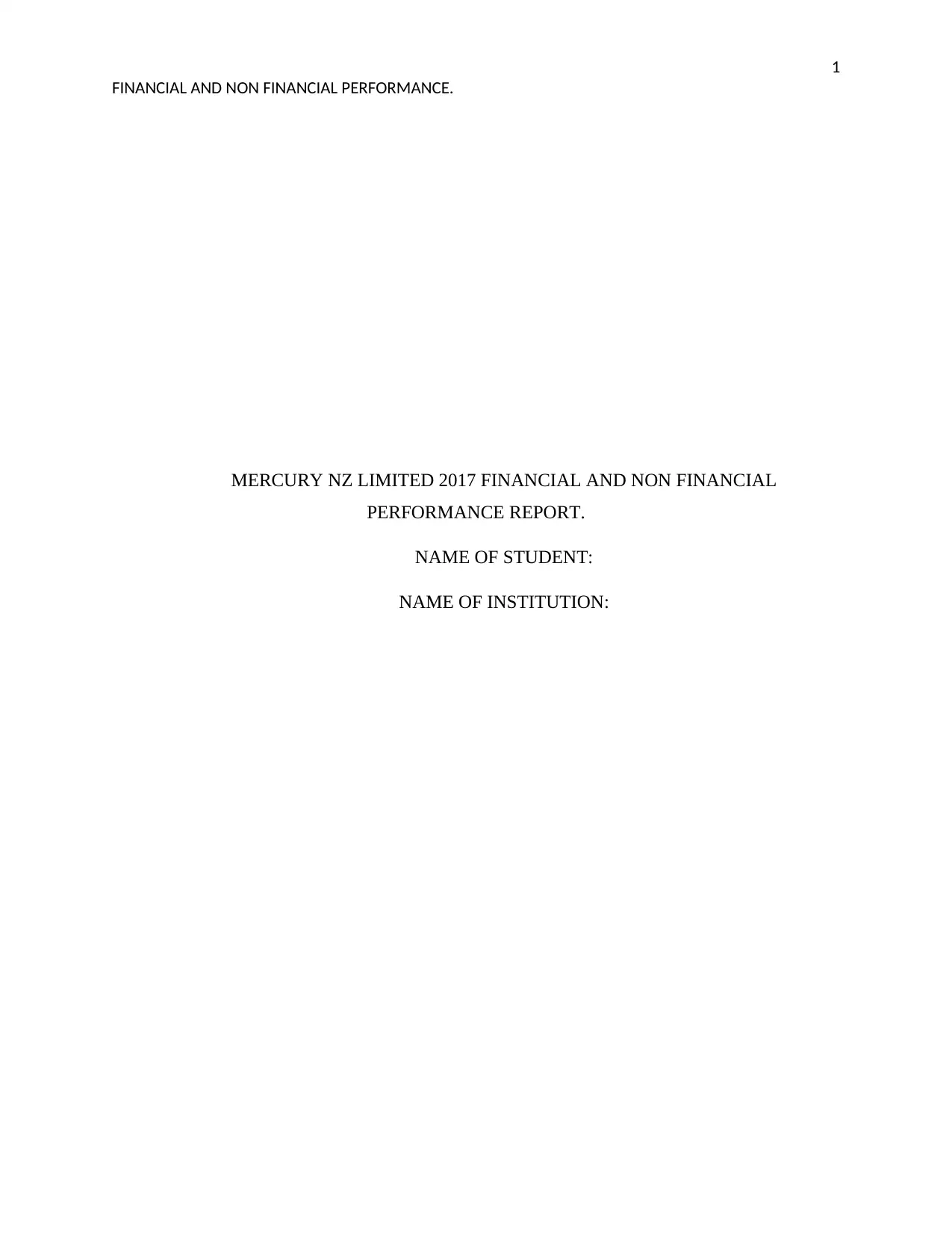
1
FINANCIAL AND NON FINANCIAL PERFORMANCE.
MERCURY NZ LIMITED 2017 FINANCIAL AND NON FINANCIAL
PERFORMANCE REPORT.
NAME OF STUDENT:
NAME OF INSTITUTION:
FINANCIAL AND NON FINANCIAL PERFORMANCE.
MERCURY NZ LIMITED 2017 FINANCIAL AND NON FINANCIAL
PERFORMANCE REPORT.
NAME OF STUDENT:
NAME OF INSTITUTION:
Paraphrase This Document
Need a fresh take? Get an instant paraphrase of this document with our AI Paraphraser
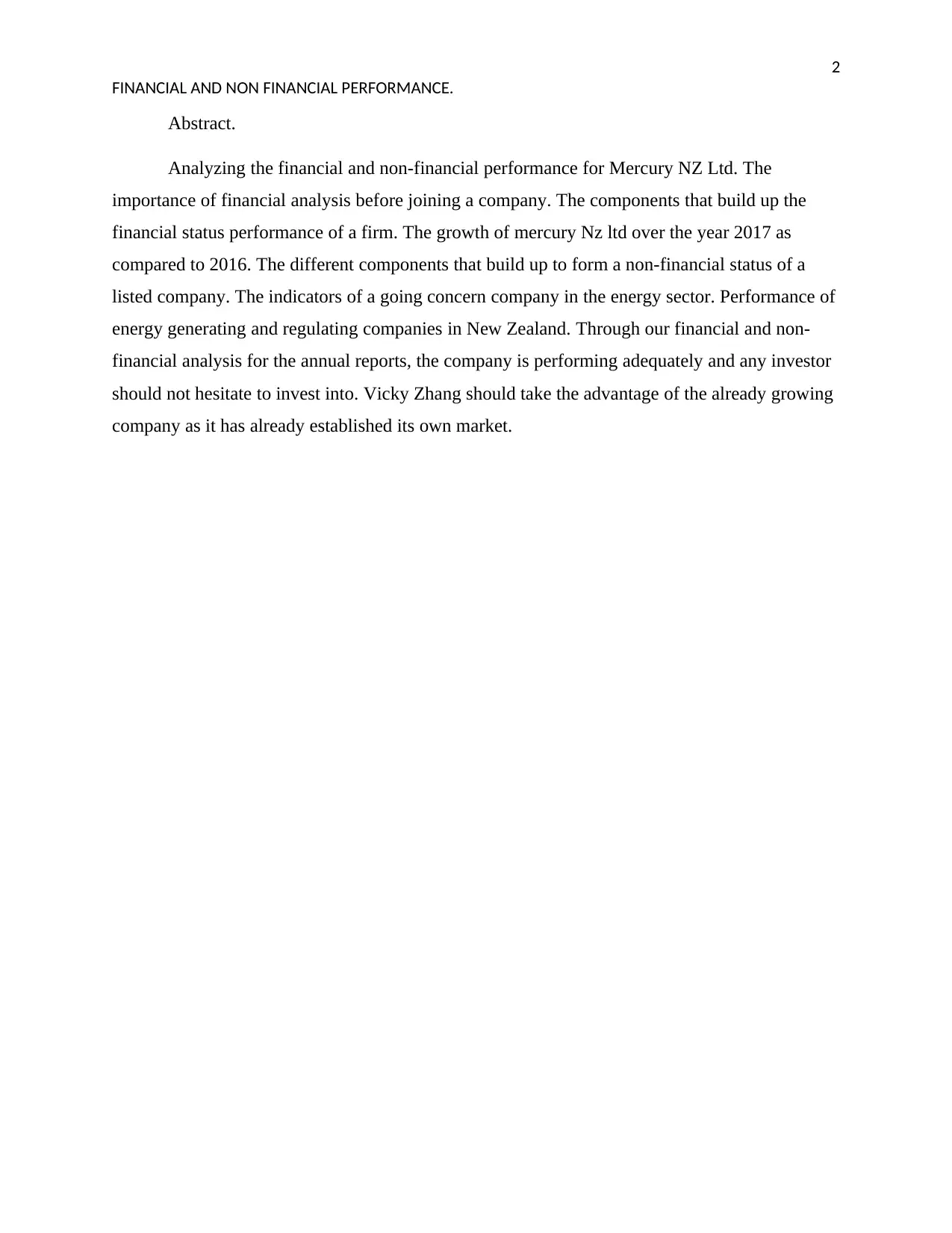
2
FINANCIAL AND NON FINANCIAL PERFORMANCE.
Abstract.
Analyzing the financial and non-financial performance for Mercury NZ Ltd. The
importance of financial analysis before joining a company. The components that build up the
financial status performance of a firm. The growth of mercury Nz ltd over the year 2017 as
compared to 2016. The different components that build up to form a non-financial status of a
listed company. The indicators of a going concern company in the energy sector. Performance of
energy generating and regulating companies in New Zealand. Through our financial and non-
financial analysis for the annual reports, the company is performing adequately and any investor
should not hesitate to invest into. Vicky Zhang should take the advantage of the already growing
company as it has already established its own market.
FINANCIAL AND NON FINANCIAL PERFORMANCE.
Abstract.
Analyzing the financial and non-financial performance for Mercury NZ Ltd. The
importance of financial analysis before joining a company. The components that build up the
financial status performance of a firm. The growth of mercury Nz ltd over the year 2017 as
compared to 2016. The different components that build up to form a non-financial status of a
listed company. The indicators of a going concern company in the energy sector. Performance of
energy generating and regulating companies in New Zealand. Through our financial and non-
financial analysis for the annual reports, the company is performing adequately and any investor
should not hesitate to invest into. Vicky Zhang should take the advantage of the already growing
company as it has already established its own market.
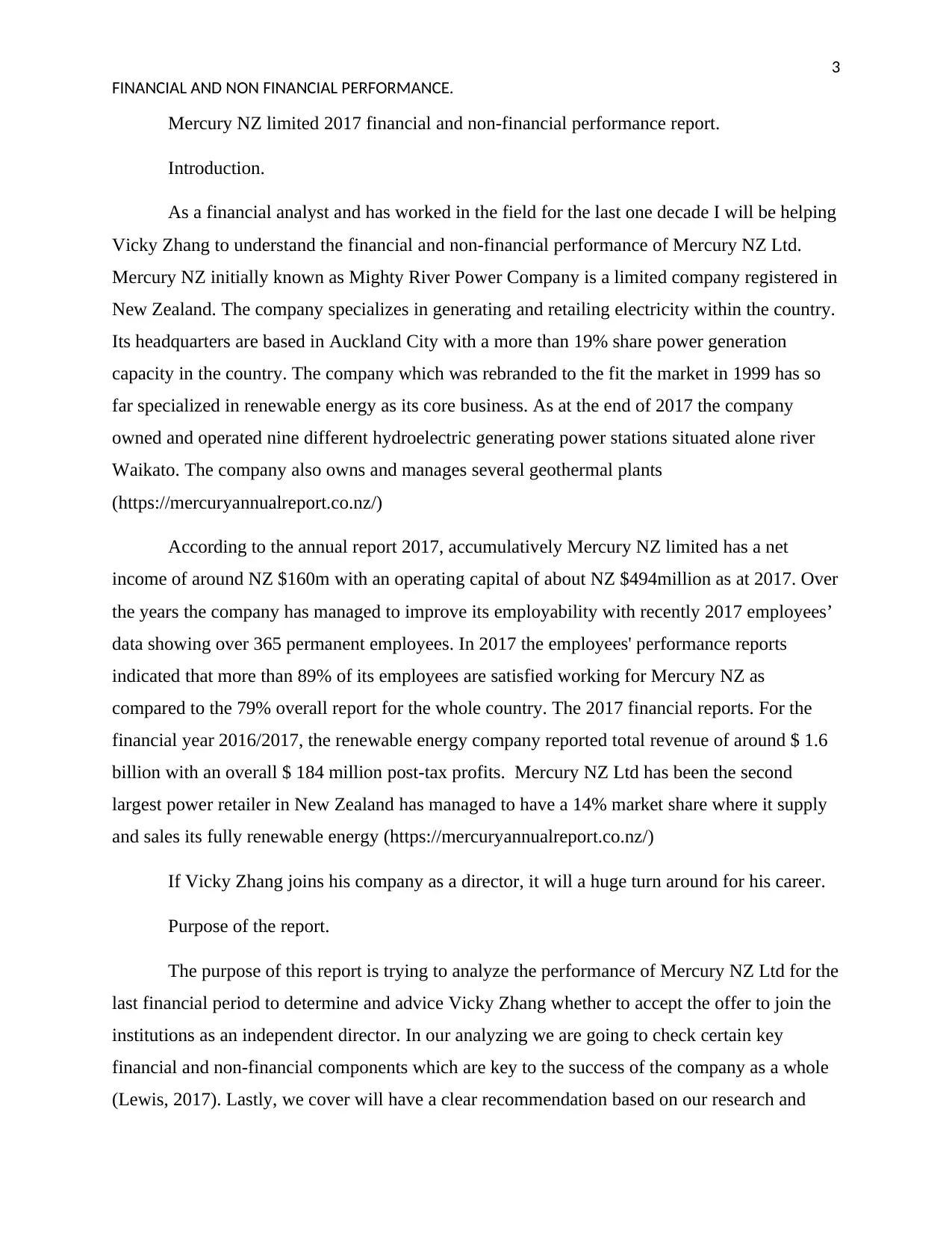
3
FINANCIAL AND NON FINANCIAL PERFORMANCE.
Mercury NZ limited 2017 financial and non-financial performance report.
Introduction.
As a financial analyst and has worked in the field for the last one decade I will be helping
Vicky Zhang to understand the financial and non-financial performance of Mercury NZ Ltd.
Mercury NZ initially known as Mighty River Power Company is a limited company registered in
New Zealand. The company specializes in generating and retailing electricity within the country.
Its headquarters are based in Auckland City with a more than 19% share power generation
capacity in the country. The company which was rebranded to the fit the market in 1999 has so
far specialized in renewable energy as its core business. As at the end of 2017 the company
owned and operated nine different hydroelectric generating power stations situated alone river
Waikato. The company also owns and manages several geothermal plants
(https://mercuryannualreport.co.nz/)
According to the annual report 2017, accumulatively Mercury NZ limited has a net
income of around NZ $160m with an operating capital of about NZ $494million as at 2017. Over
the years the company has managed to improve its employability with recently 2017 employees’
data showing over 365 permanent employees. In 2017 the employees' performance reports
indicated that more than 89% of its employees are satisfied working for Mercury NZ as
compared to the 79% overall report for the whole country. The 2017 financial reports. For the
financial year 2016/2017, the renewable energy company reported total revenue of around $ 1.6
billion with an overall $ 184 million post-tax profits. Mercury NZ Ltd has been the second
largest power retailer in New Zealand has managed to have a 14% market share where it supply
and sales its fully renewable energy (https://mercuryannualreport.co.nz/)
If Vicky Zhang joins his company as a director, it will a huge turn around for his career.
Purpose of the report.
The purpose of this report is trying to analyze the performance of Mercury NZ Ltd for the
last financial period to determine and advice Vicky Zhang whether to accept the offer to join the
institutions as an independent director. In our analyzing we are going to check certain key
financial and non-financial components which are key to the success of the company as a whole
(Lewis, 2017). Lastly, we cover will have a clear recommendation based on our research and
FINANCIAL AND NON FINANCIAL PERFORMANCE.
Mercury NZ limited 2017 financial and non-financial performance report.
Introduction.
As a financial analyst and has worked in the field for the last one decade I will be helping
Vicky Zhang to understand the financial and non-financial performance of Mercury NZ Ltd.
Mercury NZ initially known as Mighty River Power Company is a limited company registered in
New Zealand. The company specializes in generating and retailing electricity within the country.
Its headquarters are based in Auckland City with a more than 19% share power generation
capacity in the country. The company which was rebranded to the fit the market in 1999 has so
far specialized in renewable energy as its core business. As at the end of 2017 the company
owned and operated nine different hydroelectric generating power stations situated alone river
Waikato. The company also owns and manages several geothermal plants
(https://mercuryannualreport.co.nz/)
According to the annual report 2017, accumulatively Mercury NZ limited has a net
income of around NZ $160m with an operating capital of about NZ $494million as at 2017. Over
the years the company has managed to improve its employability with recently 2017 employees’
data showing over 365 permanent employees. In 2017 the employees' performance reports
indicated that more than 89% of its employees are satisfied working for Mercury NZ as
compared to the 79% overall report for the whole country. The 2017 financial reports. For the
financial year 2016/2017, the renewable energy company reported total revenue of around $ 1.6
billion with an overall $ 184 million post-tax profits. Mercury NZ Ltd has been the second
largest power retailer in New Zealand has managed to have a 14% market share where it supply
and sales its fully renewable energy (https://mercuryannualreport.co.nz/)
If Vicky Zhang joins his company as a director, it will a huge turn around for his career.
Purpose of the report.
The purpose of this report is trying to analyze the performance of Mercury NZ Ltd for the
last financial period to determine and advice Vicky Zhang whether to accept the offer to join the
institutions as an independent director. In our analyzing we are going to check certain key
financial and non-financial components which are key to the success of the company as a whole
(Lewis, 2017). Lastly, we cover will have a clear recommendation based on our research and
⊘ This is a preview!⊘
Do you want full access?
Subscribe today to unlock all pages.

Trusted by 1+ million students worldwide
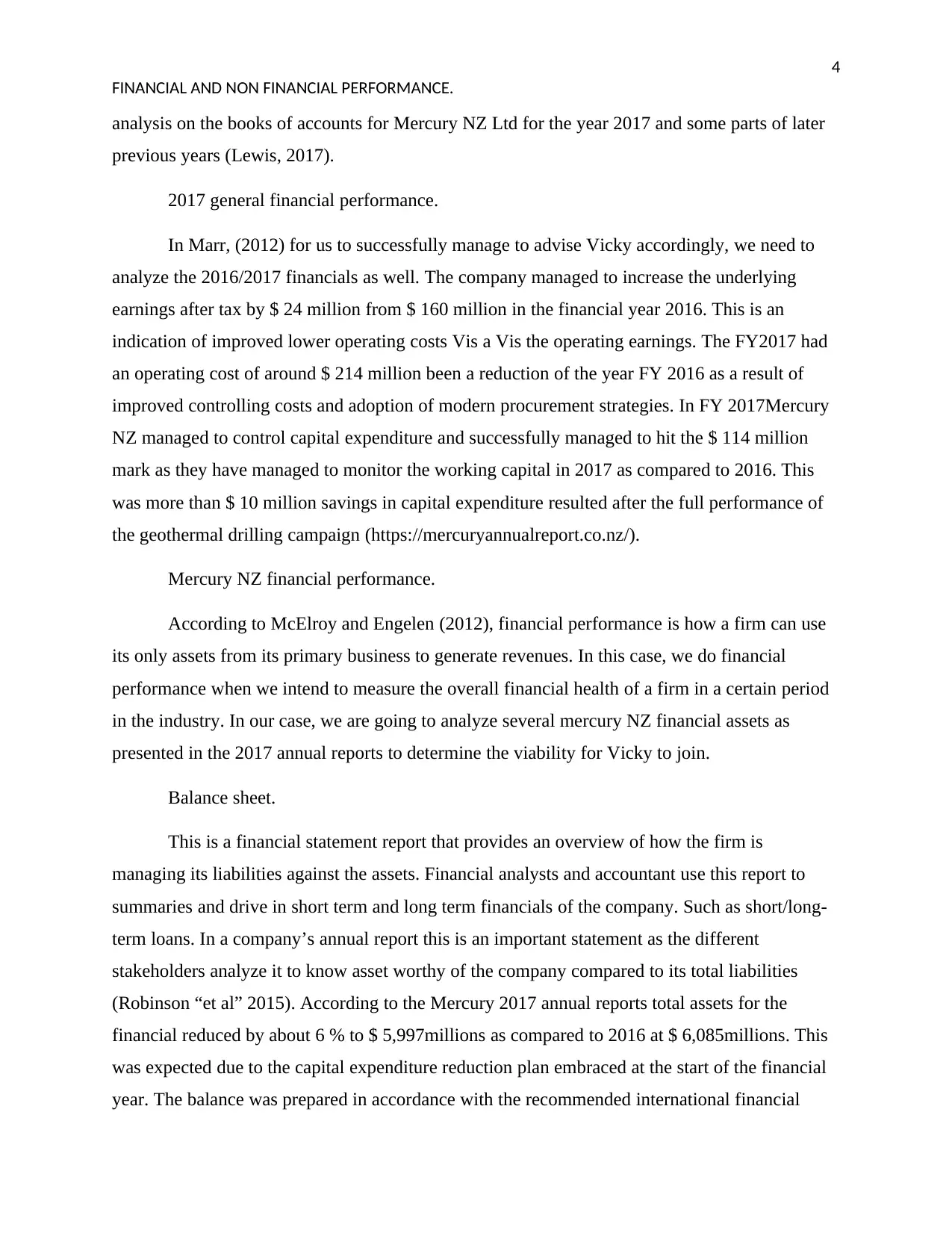
4
FINANCIAL AND NON FINANCIAL PERFORMANCE.
analysis on the books of accounts for Mercury NZ Ltd for the year 2017 and some parts of later
previous years (Lewis, 2017).
2017 general financial performance.
In Marr, (2012) for us to successfully manage to advise Vicky accordingly, we need to
analyze the 2016/2017 financials as well. The company managed to increase the underlying
earnings after tax by $ 24 million from $ 160 million in the financial year 2016. This is an
indication of improved lower operating costs Vis a Vis the operating earnings. The FY2017 had
an operating cost of around $ 214 million been a reduction of the year FY 2016 as a result of
improved controlling costs and adoption of modern procurement strategies. In FY 2017Mercury
NZ managed to control capital expenditure and successfully managed to hit the $ 114 million
mark as they have managed to monitor the working capital in 2017 as compared to 2016. This
was more than $ 10 million savings in capital expenditure resulted after the full performance of
the geothermal drilling campaign (https://mercuryannualreport.co.nz/).
Mercury NZ financial performance.
According to McElroy and Engelen (2012), financial performance is how a firm can use
its only assets from its primary business to generate revenues. In this case, we do financial
performance when we intend to measure the overall financial health of a firm in a certain period
in the industry. In our case, we are going to analyze several mercury NZ financial assets as
presented in the 2017 annual reports to determine the viability for Vicky to join.
Balance sheet.
This is a financial statement report that provides an overview of how the firm is
managing its liabilities against the assets. Financial analysts and accountant use this report to
summaries and drive in short term and long term financials of the company. Such as short/long-
term loans. In a company’s annual report this is an important statement as the different
stakeholders analyze it to know asset worthy of the company compared to its total liabilities
(Robinson “et al” 2015). According to the Mercury 2017 annual reports total assets for the
financial reduced by about 6 % to $ 5,997millions as compared to 2016 at $ 6,085millions. This
was expected due to the capital expenditure reduction plan embraced at the start of the financial
year. The balance was prepared in accordance with the recommended international financial
FINANCIAL AND NON FINANCIAL PERFORMANCE.
analysis on the books of accounts for Mercury NZ Ltd for the year 2017 and some parts of later
previous years (Lewis, 2017).
2017 general financial performance.
In Marr, (2012) for us to successfully manage to advise Vicky accordingly, we need to
analyze the 2016/2017 financials as well. The company managed to increase the underlying
earnings after tax by $ 24 million from $ 160 million in the financial year 2016. This is an
indication of improved lower operating costs Vis a Vis the operating earnings. The FY2017 had
an operating cost of around $ 214 million been a reduction of the year FY 2016 as a result of
improved controlling costs and adoption of modern procurement strategies. In FY 2017Mercury
NZ managed to control capital expenditure and successfully managed to hit the $ 114 million
mark as they have managed to monitor the working capital in 2017 as compared to 2016. This
was more than $ 10 million savings in capital expenditure resulted after the full performance of
the geothermal drilling campaign (https://mercuryannualreport.co.nz/).
Mercury NZ financial performance.
According to McElroy and Engelen (2012), financial performance is how a firm can use
its only assets from its primary business to generate revenues. In this case, we do financial
performance when we intend to measure the overall financial health of a firm in a certain period
in the industry. In our case, we are going to analyze several mercury NZ financial assets as
presented in the 2017 annual reports to determine the viability for Vicky to join.
Balance sheet.
This is a financial statement report that provides an overview of how the firm is
managing its liabilities against the assets. Financial analysts and accountant use this report to
summaries and drive in short term and long term financials of the company. Such as short/long-
term loans. In a company’s annual report this is an important statement as the different
stakeholders analyze it to know asset worthy of the company compared to its total liabilities
(Robinson “et al” 2015). According to the Mercury 2017 annual reports total assets for the
financial reduced by about 6 % to $ 5,997millions as compared to 2016 at $ 6,085millions. This
was expected due to the capital expenditure reduction plan embraced at the start of the financial
year. The balance was prepared in accordance with the recommended international financial
Paraphrase This Document
Need a fresh take? Get an instant paraphrase of this document with our AI Paraphraser
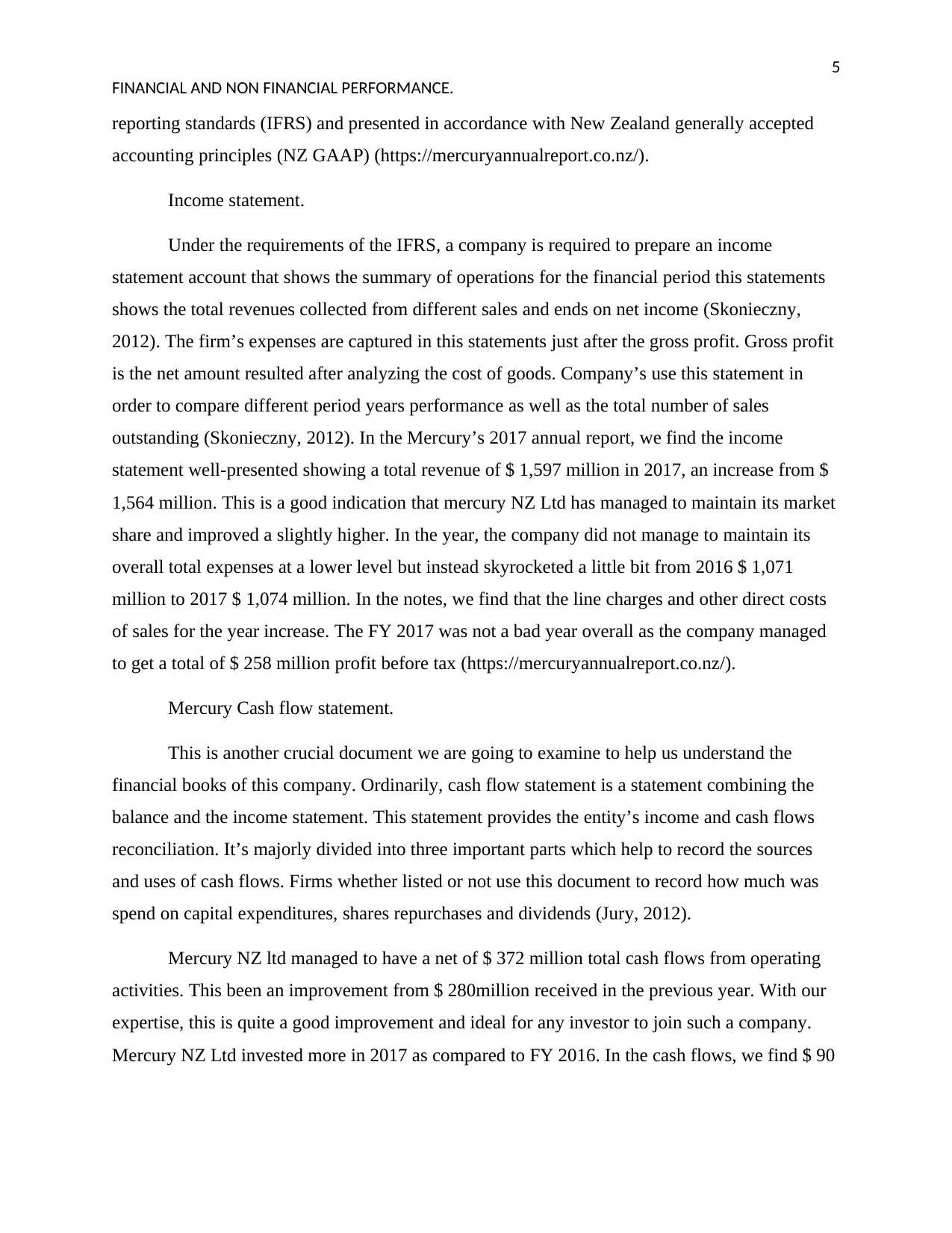
5
FINANCIAL AND NON FINANCIAL PERFORMANCE.
reporting standards (IFRS) and presented in accordance with New Zealand generally accepted
accounting principles (NZ GAAP) (https://mercuryannualreport.co.nz/).
Income statement.
Under the requirements of the IFRS, a company is required to prepare an income
statement account that shows the summary of operations for the financial period this statements
shows the total revenues collected from different sales and ends on net income (Skonieczny,
2012). The firm’s expenses are captured in this statements just after the gross profit. Gross profit
is the net amount resulted after analyzing the cost of goods. Company’s use this statement in
order to compare different period years performance as well as the total number of sales
outstanding (Skonieczny, 2012). In the Mercury’s 2017 annual report, we find the income
statement well-presented showing a total revenue of $ 1,597 million in 2017, an increase from $
1,564 million. This is a good indication that mercury NZ Ltd has managed to maintain its market
share and improved a slightly higher. In the year, the company did not manage to maintain its
overall total expenses at a lower level but instead skyrocketed a little bit from 2016 $ 1,071
million to 2017 $ 1,074 million. In the notes, we find that the line charges and other direct costs
of sales for the year increase. The FY 2017 was not a bad year overall as the company managed
to get a total of $ 258 million profit before tax (https://mercuryannualreport.co.nz/).
Mercury Cash flow statement.
This is another crucial document we are going to examine to help us understand the
financial books of this company. Ordinarily, cash flow statement is a statement combining the
balance and the income statement. This statement provides the entity’s income and cash flows
reconciliation. It’s majorly divided into three important parts which help to record the sources
and uses of cash flows. Firms whether listed or not use this document to record how much was
spend on capital expenditures, shares repurchases and dividends (Jury, 2012).
Mercury NZ ltd managed to have a net of $ 372 million total cash flows from operating
activities. This been an improvement from $ 280million received in the previous year. With our
expertise, this is quite a good improvement and ideal for any investor to join such a company.
Mercury NZ Ltd invested more in 2017 as compared to FY 2016. In the cash flows, we find $ 90
FINANCIAL AND NON FINANCIAL PERFORMANCE.
reporting standards (IFRS) and presented in accordance with New Zealand generally accepted
accounting principles (NZ GAAP) (https://mercuryannualreport.co.nz/).
Income statement.
Under the requirements of the IFRS, a company is required to prepare an income
statement account that shows the summary of operations for the financial period this statements
shows the total revenues collected from different sales and ends on net income (Skonieczny,
2012). The firm’s expenses are captured in this statements just after the gross profit. Gross profit
is the net amount resulted after analyzing the cost of goods. Company’s use this statement in
order to compare different period years performance as well as the total number of sales
outstanding (Skonieczny, 2012). In the Mercury’s 2017 annual report, we find the income
statement well-presented showing a total revenue of $ 1,597 million in 2017, an increase from $
1,564 million. This is a good indication that mercury NZ Ltd has managed to maintain its market
share and improved a slightly higher. In the year, the company did not manage to maintain its
overall total expenses at a lower level but instead skyrocketed a little bit from 2016 $ 1,071
million to 2017 $ 1,074 million. In the notes, we find that the line charges and other direct costs
of sales for the year increase. The FY 2017 was not a bad year overall as the company managed
to get a total of $ 258 million profit before tax (https://mercuryannualreport.co.nz/).
Mercury Cash flow statement.
This is another crucial document we are going to examine to help us understand the
financial books of this company. Ordinarily, cash flow statement is a statement combining the
balance and the income statement. This statement provides the entity’s income and cash flows
reconciliation. It’s majorly divided into three important parts which help to record the sources
and uses of cash flows. Firms whether listed or not use this document to record how much was
spend on capital expenditures, shares repurchases and dividends (Jury, 2012).
Mercury NZ ltd managed to have a net of $ 372 million total cash flows from operating
activities. This been an improvement from $ 280million received in the previous year. With our
expertise, this is quite a good improvement and ideal for any investor to join such a company.
Mercury NZ Ltd invested more in 2017 as compared to FY 2016. In the cash flows, we find $ 90
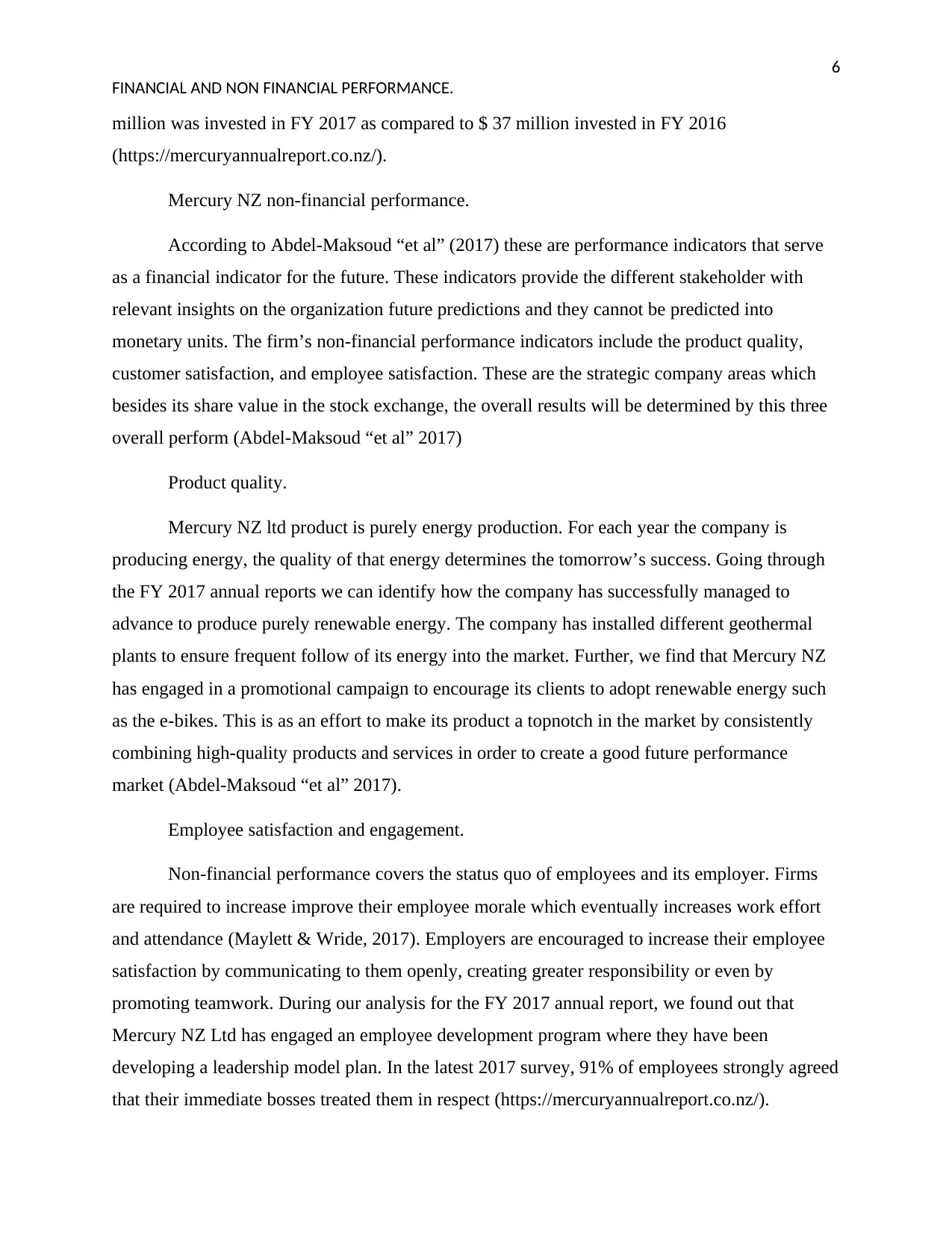
6
FINANCIAL AND NON FINANCIAL PERFORMANCE.
million was invested in FY 2017 as compared to $ 37 million invested in FY 2016
(https://mercuryannualreport.co.nz/).
Mercury NZ non-financial performance.
According to Abdel-Maksoud “et al” (2017) these are performance indicators that serve
as a financial indicator for the future. These indicators provide the different stakeholder with
relevant insights on the organization future predictions and they cannot be predicted into
monetary units. The firm’s non-financial performance indicators include the product quality,
customer satisfaction, and employee satisfaction. These are the strategic company areas which
besides its share value in the stock exchange, the overall results will be determined by this three
overall perform (Abdel-Maksoud “et al” 2017)
Product quality.
Mercury NZ ltd product is purely energy production. For each year the company is
producing energy, the quality of that energy determines the tomorrow’s success. Going through
the FY 2017 annual reports we can identify how the company has successfully managed to
advance to produce purely renewable energy. The company has installed different geothermal
plants to ensure frequent follow of its energy into the market. Further, we find that Mercury NZ
has engaged in a promotional campaign to encourage its clients to adopt renewable energy such
as the e-bikes. This is as an effort to make its product a topnotch in the market by consistently
combining high-quality products and services in order to create a good future performance
market (Abdel-Maksoud “et al” 2017).
Employee satisfaction and engagement.
Non-financial performance covers the status quo of employees and its employer. Firms
are required to increase improve their employee morale which eventually increases work effort
and attendance (Maylett & Wride, 2017). Employers are encouraged to increase their employee
satisfaction by communicating to them openly, creating greater responsibility or even by
promoting teamwork. During our analysis for the FY 2017 annual report, we found out that
Mercury NZ Ltd has engaged an employee development program where they have been
developing a leadership model plan. In the latest 2017 survey, 91% of employees strongly agreed
that their immediate bosses treated them in respect (https://mercuryannualreport.co.nz/).
FINANCIAL AND NON FINANCIAL PERFORMANCE.
million was invested in FY 2017 as compared to $ 37 million invested in FY 2016
(https://mercuryannualreport.co.nz/).
Mercury NZ non-financial performance.
According to Abdel-Maksoud “et al” (2017) these are performance indicators that serve
as a financial indicator for the future. These indicators provide the different stakeholder with
relevant insights on the organization future predictions and they cannot be predicted into
monetary units. The firm’s non-financial performance indicators include the product quality,
customer satisfaction, and employee satisfaction. These are the strategic company areas which
besides its share value in the stock exchange, the overall results will be determined by this three
overall perform (Abdel-Maksoud “et al” 2017)
Product quality.
Mercury NZ ltd product is purely energy production. For each year the company is
producing energy, the quality of that energy determines the tomorrow’s success. Going through
the FY 2017 annual reports we can identify how the company has successfully managed to
advance to produce purely renewable energy. The company has installed different geothermal
plants to ensure frequent follow of its energy into the market. Further, we find that Mercury NZ
has engaged in a promotional campaign to encourage its clients to adopt renewable energy such
as the e-bikes. This is as an effort to make its product a topnotch in the market by consistently
combining high-quality products and services in order to create a good future performance
market (Abdel-Maksoud “et al” 2017).
Employee satisfaction and engagement.
Non-financial performance covers the status quo of employees and its employer. Firms
are required to increase improve their employee morale which eventually increases work effort
and attendance (Maylett & Wride, 2017). Employers are encouraged to increase their employee
satisfaction by communicating to them openly, creating greater responsibility or even by
promoting teamwork. During our analysis for the FY 2017 annual report, we found out that
Mercury NZ Ltd has engaged an employee development program where they have been
developing a leadership model plan. In the latest 2017 survey, 91% of employees strongly agreed
that their immediate bosses treated them in respect (https://mercuryannualreport.co.nz/).
⊘ This is a preview!⊘
Do you want full access?
Subscribe today to unlock all pages.

Trusted by 1+ million students worldwide
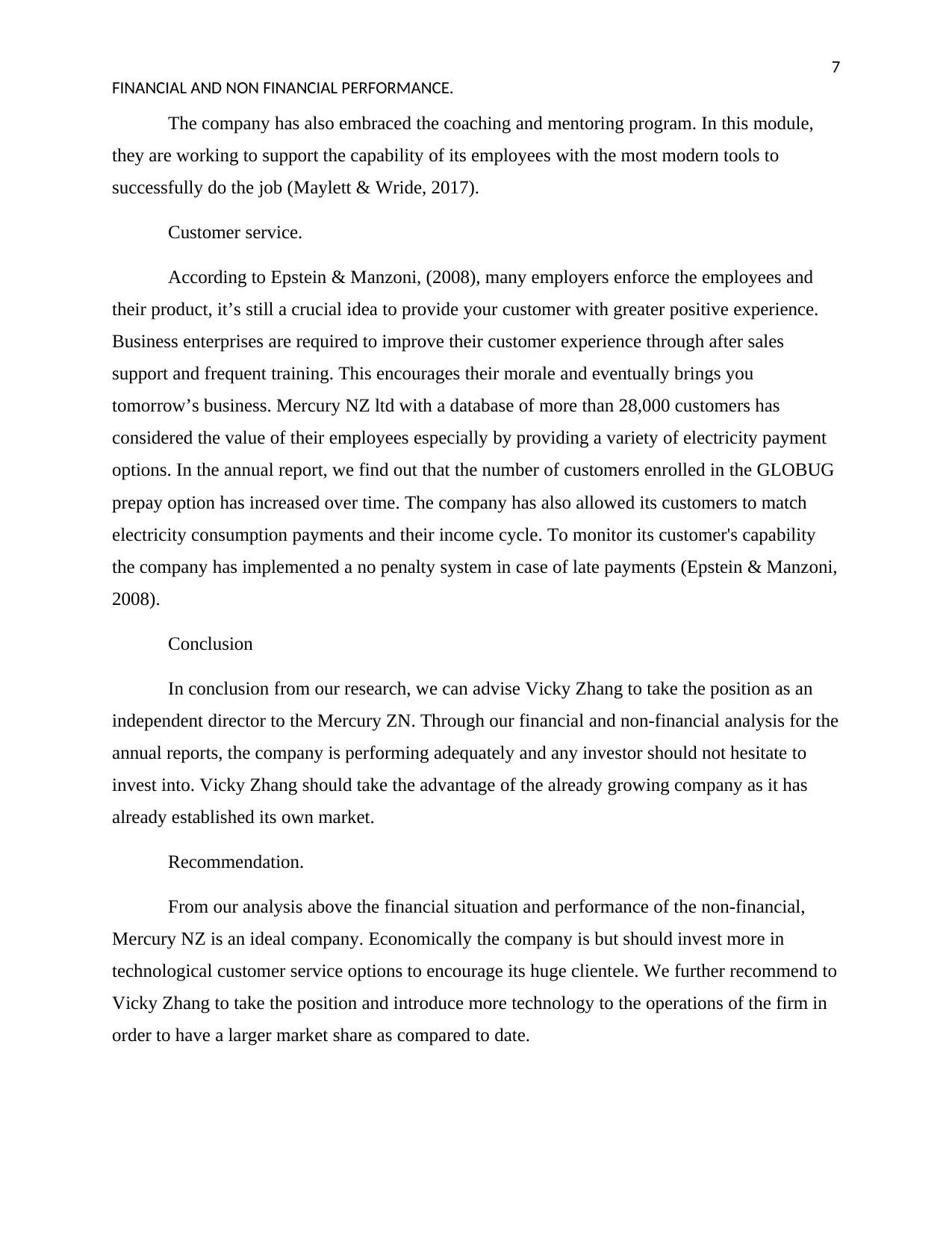
7
FINANCIAL AND NON FINANCIAL PERFORMANCE.
The company has also embraced the coaching and mentoring program. In this module,
they are working to support the capability of its employees with the most modern tools to
successfully do the job (Maylett & Wride, 2017).
Customer service.
According to Epstein & Manzoni, (2008), many employers enforce the employees and
their product, it’s still a crucial idea to provide your customer with greater positive experience.
Business enterprises are required to improve their customer experience through after sales
support and frequent training. This encourages their morale and eventually brings you
tomorrow’s business. Mercury NZ ltd with a database of more than 28,000 customers has
considered the value of their employees especially by providing a variety of electricity payment
options. In the annual report, we find out that the number of customers enrolled in the GLOBUG
prepay option has increased over time. The company has also allowed its customers to match
electricity consumption payments and their income cycle. To monitor its customer's capability
the company has implemented a no penalty system in case of late payments (Epstein & Manzoni,
2008).
Conclusion
In conclusion from our research, we can advise Vicky Zhang to take the position as an
independent director to the Mercury ZN. Through our financial and non-financial analysis for the
annual reports, the company is performing adequately and any investor should not hesitate to
invest into. Vicky Zhang should take the advantage of the already growing company as it has
already established its own market.
Recommendation.
From our analysis above the financial situation and performance of the non-financial,
Mercury NZ is an ideal company. Economically the company is but should invest more in
technological customer service options to encourage its huge clientele. We further recommend to
Vicky Zhang to take the position and introduce more technology to the operations of the firm in
order to have a larger market share as compared to date.
FINANCIAL AND NON FINANCIAL PERFORMANCE.
The company has also embraced the coaching and mentoring program. In this module,
they are working to support the capability of its employees with the most modern tools to
successfully do the job (Maylett & Wride, 2017).
Customer service.
According to Epstein & Manzoni, (2008), many employers enforce the employees and
their product, it’s still a crucial idea to provide your customer with greater positive experience.
Business enterprises are required to improve their customer experience through after sales
support and frequent training. This encourages their morale and eventually brings you
tomorrow’s business. Mercury NZ ltd with a database of more than 28,000 customers has
considered the value of their employees especially by providing a variety of electricity payment
options. In the annual report, we find out that the number of customers enrolled in the GLOBUG
prepay option has increased over time. The company has also allowed its customers to match
electricity consumption payments and their income cycle. To monitor its customer's capability
the company has implemented a no penalty system in case of late payments (Epstein & Manzoni,
2008).
Conclusion
In conclusion from our research, we can advise Vicky Zhang to take the position as an
independent director to the Mercury ZN. Through our financial and non-financial analysis for the
annual reports, the company is performing adequately and any investor should not hesitate to
invest into. Vicky Zhang should take the advantage of the already growing company as it has
already established its own market.
Recommendation.
From our analysis above the financial situation and performance of the non-financial,
Mercury NZ is an ideal company. Economically the company is but should invest more in
technological customer service options to encourage its huge clientele. We further recommend to
Vicky Zhang to take the position and introduce more technology to the operations of the firm in
order to have a larger market share as compared to date.
Paraphrase This Document
Need a fresh take? Get an instant paraphrase of this document with our AI Paraphraser
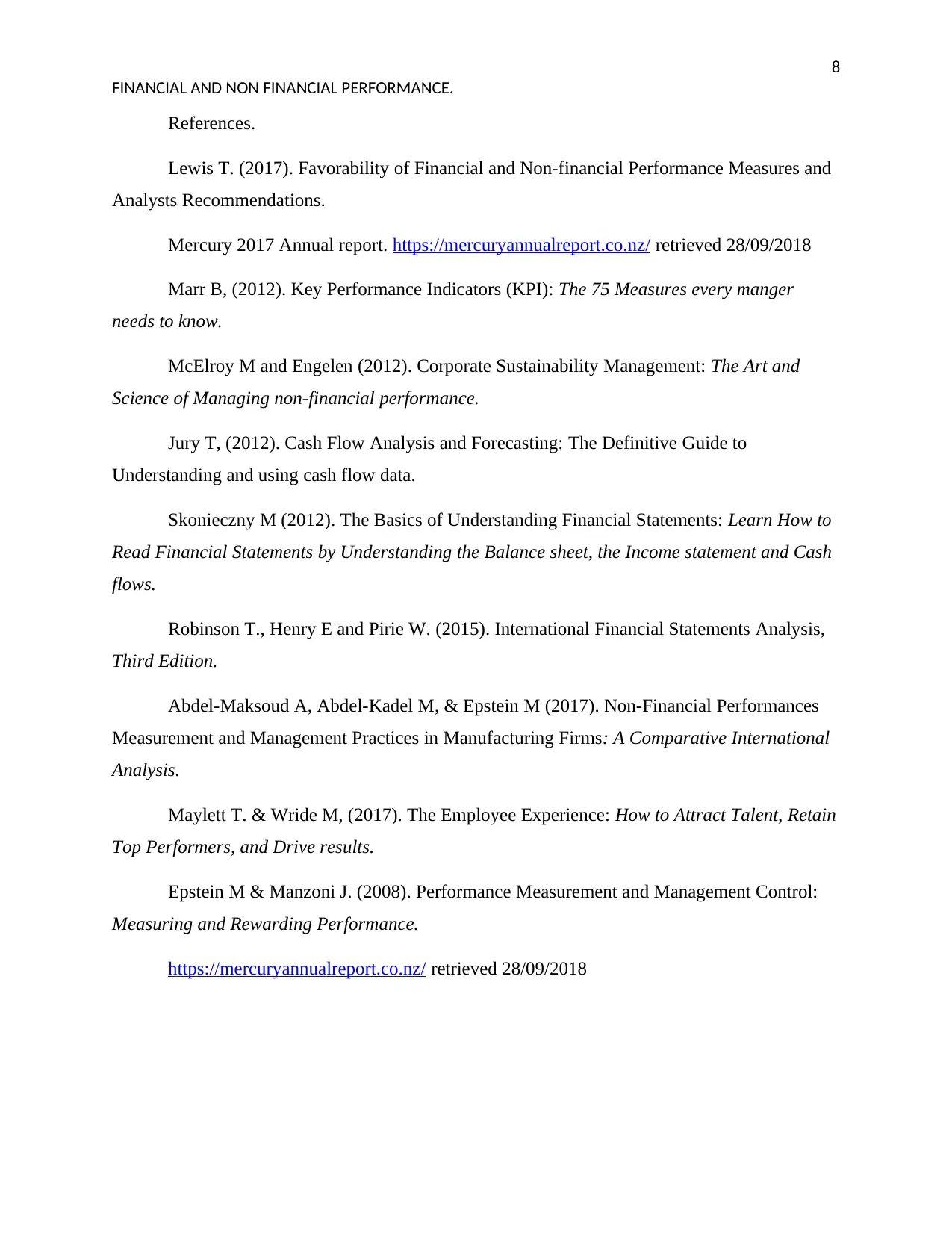
8
FINANCIAL AND NON FINANCIAL PERFORMANCE.
References.
Lewis T. (2017). Favorability of Financial and Non-financial Performance Measures and
Analysts Recommendations.
Mercury 2017 Annual report. https://mercuryannualreport.co.nz/ retrieved 28/09/2018
Marr B, (2012). Key Performance Indicators (KPI): The 75 Measures every manger
needs to know.
McElroy M and Engelen (2012). Corporate Sustainability Management: The Art and
Science of Managing non-financial performance.
Jury T, (2012). Cash Flow Analysis and Forecasting: The Definitive Guide to
Understanding and using cash flow data.
Skonieczny M (2012). The Basics of Understanding Financial Statements: Learn How to
Read Financial Statements by Understanding the Balance sheet, the Income statement and Cash
flows.
Robinson T., Henry E and Pirie W. (2015). International Financial Statements Analysis,
Third Edition.
Abdel-Maksoud A, Abdel-Kadel M, & Epstein M (2017). Non-Financial Performances
Measurement and Management Practices in Manufacturing Firms: A Comparative International
Analysis.
Maylett T. & Wride M, (2017). The Employee Experience: How to Attract Talent, Retain
Top Performers, and Drive results.
Epstein M & Manzoni J. (2008). Performance Measurement and Management Control:
Measuring and Rewarding Performance.
https://mercuryannualreport.co.nz/ retrieved 28/09/2018
FINANCIAL AND NON FINANCIAL PERFORMANCE.
References.
Lewis T. (2017). Favorability of Financial and Non-financial Performance Measures and
Analysts Recommendations.
Mercury 2017 Annual report. https://mercuryannualreport.co.nz/ retrieved 28/09/2018
Marr B, (2012). Key Performance Indicators (KPI): The 75 Measures every manger
needs to know.
McElroy M and Engelen (2012). Corporate Sustainability Management: The Art and
Science of Managing non-financial performance.
Jury T, (2012). Cash Flow Analysis and Forecasting: The Definitive Guide to
Understanding and using cash flow data.
Skonieczny M (2012). The Basics of Understanding Financial Statements: Learn How to
Read Financial Statements by Understanding the Balance sheet, the Income statement and Cash
flows.
Robinson T., Henry E and Pirie W. (2015). International Financial Statements Analysis,
Third Edition.
Abdel-Maksoud A, Abdel-Kadel M, & Epstein M (2017). Non-Financial Performances
Measurement and Management Practices in Manufacturing Firms: A Comparative International
Analysis.
Maylett T. & Wride M, (2017). The Employee Experience: How to Attract Talent, Retain
Top Performers, and Drive results.
Epstein M & Manzoni J. (2008). Performance Measurement and Management Control:
Measuring and Rewarding Performance.
https://mercuryannualreport.co.nz/ retrieved 28/09/2018
1 out of 8
Related Documents
Your All-in-One AI-Powered Toolkit for Academic Success.
+13062052269
info@desklib.com
Available 24*7 on WhatsApp / Email
![[object Object]](/_next/static/media/star-bottom.7253800d.svg)
Unlock your academic potential
Copyright © 2020–2025 A2Z Services. All Rights Reserved. Developed and managed by ZUCOL.




